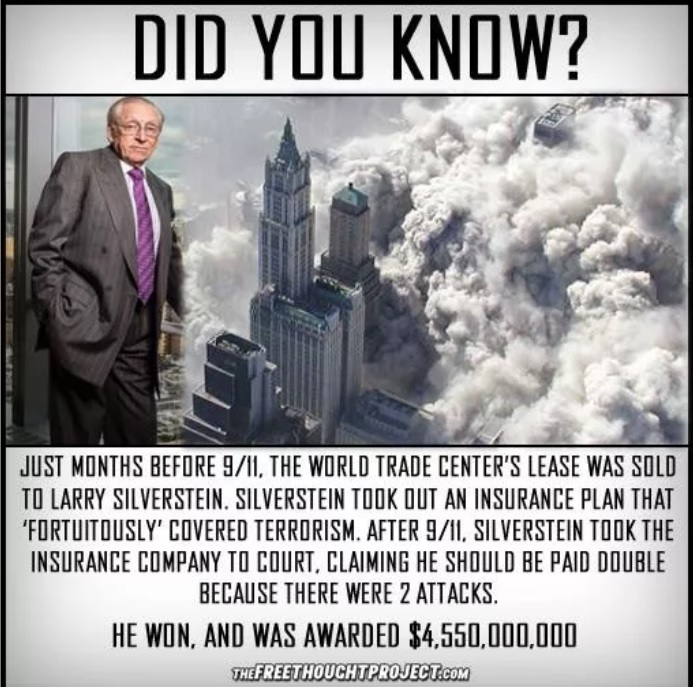Some of the most persistent contemporary legends about the 9/11 attacks involve people supposedly benefiting from foreknowledge of the event, whether it be a group of World Trade Center workers who "fortuitously" called in sick and escaped certain death that day, or investors who "fortuitously" bought "put options" on United and American Airlines stock immediately before the attacks, thus profiting when the prices of those stocks fell afterwards.
American businessman Larry Silverstein, who famously signed a 99-year lease on the World Trade Center complex in June 2001, two months before the attacks, is at the center of another story about profiting from the event:
Just months before 9/11, the World Trade Center's lease was sold to Larry Silverstein. Silverstein took out an insurance plan that 'fortuitously' covered terrorism. After 9/11, Silverstein took the insurance company to court, claiming he should be paid double because there were 2 attacks. He won, and was awarded $4,550,000,000.
While the story obviously contains elements of fact, it's also partly fiction — most notably the implication, made via the use of scare quotes around the word "fortuitous," that Silverstein's decision to purchase terrorism insurance just before 9/11 was no mere coincidence.

There are several underlying assumptions at work here: that the World Trade Center must not have had terrorism insurance before Silverstein took over; that selecting such coverage was purely optional; and that because he "chose" to buy such coverage when he did, Silverstein must have known in advance that (and when) terrorists would strike.
It's important to note that, despite appearances, Silverstein wasn't actually the sole leaseholder of the World Trade Center: He led a consortium of investors and lenders which included GMAC Commercial Mortgage (a General Motors subsidiary), Westfield America Inc. (a shopping center developer), and real estate investor Lloyd Goldman. All these entities had a voice in deciding how much insurance coverage the properties would have, and each had some claim on whatever insurance monies were paid out.
Bear in mind, too, that when we speak of "terrorism insurance coverage," what we're actually speaking of is coverage that doesn't have a terrorism exclusion. Such exclusions aren't uncommon now, but according to the Insurance Information Institute virtually all commercial insurance policies sold in the U.S. before 9/11 covered terrorist incidents as a matter of course (and essentially free of charge), because the risk was considered so remote. Thus, for example, the World Trade Center was fully covered when it was bombed by terrorists in 1993, and insurers paid out an estimated $510 million in damages after that incident. There's no reason to suppose that the WTC wasn't routinely covered against terrorist acts right up until the time Silverstein took over the lease in 2001.
Moreover, upon signing that lease, Silverstein was obligated to insure the World Trade Center. There was nothing strange, suspicious, or "fortuitous," therefore, about his purchasing an all-risk insurance policy — which at that time would have automatically included terrorism coverage — two months before 9/11, because that's when he became contractually responsible for doing so. Ultimately, Silverstein wasn't even solely responsible for the total dollar amount of that coverage ($3.55 billion) because that was the minimum demanded by his lenders, according to a 2002 report in The American Lawyer.
It's a fact that Silverstein took his insurers to court after 9/11 and asked for double the damages. It's also a fact that he did so on the grounds that there were two attacks (or, in insurance lingo, "occurrences"), not one. But this wasn't some premeditated scam based on foreknowledge that a terrorist attack involving two planes would occur. The cost of rebuilding the World Trade Center, which in 2004 was estimated at $9 billion, made Silverstein's court strategy a virtual necessity. Plus, he had obligations to lenders and co-investors, and still owed lease payments of $10 million per month to the Port Authority.
The court ultimately did grant Silverstein a payout of $4.55 billion, which amounted to about a third more than the maximum allowable for a single "occurrence" by his insurance policy, but significantly less than the $7.1 billion he had originally sought.

